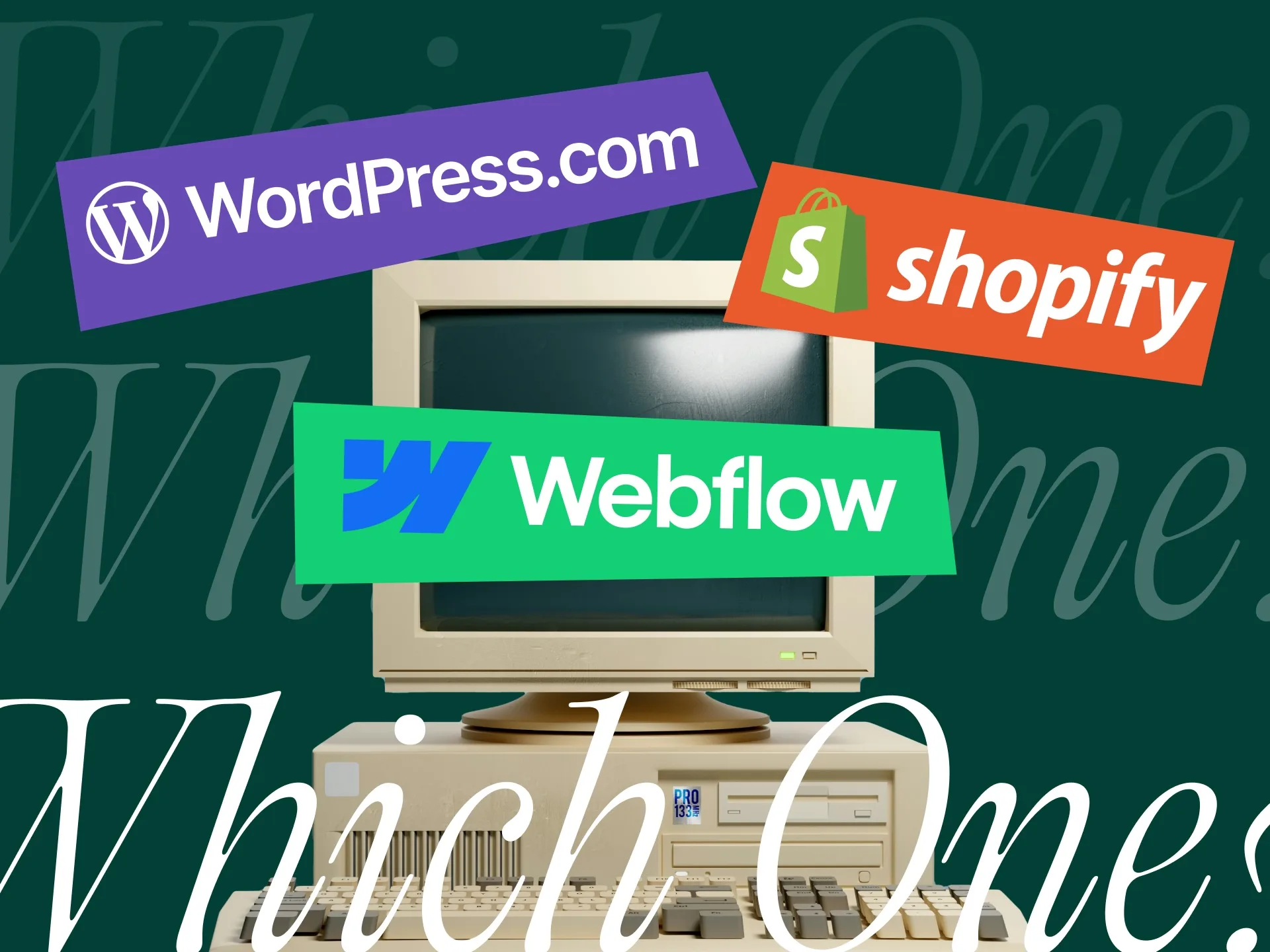
When you’re building or growing a business, your website is more than just a digital storefront—it’s your brand’s first impression. And choosing the right platform to build that website can be a tough decision. With so many options out there, how do you decide between WordPress, Webflow, and Shopify? Each of these platforms offers different advantages, so let’s break down the pros, cons, and ongoing maintenance to help you make an informed decision.
WordPress: The Flexible Powerhouse
Why Choose WordPress?
If you’re looking for a website that offers endless customization and flexibility, WordPress might be your best bet. WordPress is an open-source platform, meaning it’s fully customizable. Whether you’re launching a blog, an e-commerce site, or a portfolio, WordPress can handle it all. We’ve been building WordPress sites since we were in diapers here at Tilted Chair, so this is the platform we feel most comfortable working in.
Pros:
– Ultimate Flexibility: With thousands of themes and plugins available, WordPress can be tailored to suit virtually any business need. We have definitely taken WordPress to its limits as we design sites for our clients.
– SEO Friendly: WordPress excels in SEO capabilities, thanks to plugins like Yoast, which help optimize content for search engines.
– Community Support: It’s backed by a massive global community of developers, offering a wealth of plugins, themes, and tutorials.
Cons:
– Ongoing Security Management: Being a popular open-source platform also means WordPress is a frequent target for hackers. You’ll need security plugins and regular updates to keep your site safe.
Maintenance:
WordPress requires frequent updates to the core platform, plugins, and themes. You’ll also need to manage your own hosting, security, and backups, which adds to ongoing maintenance costs and time. We minimize this as much as possible at Tilted Chair, but be aware of this.
Is WordPress Right for You?
If you want full control over your site’s design and functionality—and don’t mind rolling up your sleeves to manage security and updates—WordPress is a solid choice, especially for complex sites or businesses with growing content needs.
—
Webflow: The Designer’s Dream
Why Choose Webflow?
Webflow is like the best of both worlds for design-focused businesses. It offers creative freedom with its drag-and-drop interface while also handling some of the technical headaches of website building for you. A lot of people think this is the platform of the future. We have definitely gotten really good at Webflow sites over the years too.
Pros:
– Design Without Limits: Webflow allows you to create visually stunning websites without needing to write code. It’s ideal for those who want pixel-perfect control over the design.
– Built-In Features: You don’t need third-party plugins for things like responsive design, animations, or a built-in CMS—it’s all baked into Webflow’s system.
– Fast Loading & Clean Code: Webflow generates clean, efficient code that makes your website fast and more SEO-friendly.
Cons:
– Not the Cheapest: Webflow’s plans can get expensive, especially as you scale. Hosting is included, but the pricing is higher compared to WordPress.
– Steeper Learning Curve for Non-Designers: While Webflow is intuitive for designers, those without a design background might find the learning curve a bit steep.
Maintenance:
Webflow takes care of most of the technical maintenance for you, including hosting, security, and platform updates. This makes ongoing maintenance far simpler than WordPress.
Is Webflow Right for You?
If you’re a design-driven business or marketing professional who values creative control but doesn’t want to worry about backend technical issues, Webflow is an excellent choice. It’s great for content-focused sites, small e-commerce stores, or creative portfolios.
—
Shopify: The E-commerce Expert
Why Choose Shopify?
If your business revolves around selling products online, Shopify is built with you in mind. It’s an all-in-one e-commerce platform that makes setting up an online store easy—even if you have zero technical experience. We have built our fair share of Shopify sites for our e-commerce clients.
Pros:
– E-commerce First: Shopify is specifically designed for online sales, with features for inventory management, payment processing, shipping, and more.
– Hassle-Free Security: Shopify handles all security and performance optimization, so you don’t have to worry about PCI compliance or SSL certificates.
– Extensive App Store: Need extra functionality? Shopify’s App Store has hundreds of apps to enhance your store’s features, from advanced product filters to marketing integrations.
Cons:
– Limited Customization: While Shopify is easy to use, it doesn’t offer the same level of design freedom as WordPress or Webflow. Advanced customizations might require learning Shopify’s proprietary coding language, Liquid.
– Transaction Fees: If you’re not using Shopify Payments, Shopify charges additional transaction fees on top of credit card processing fees, which can add up quickly.
Maintenance:
Shopify is a fully managed platform, meaning Shopify takes care of hosting, security, and updates. However, you’ll need to manage third-party apps and ensure they’re functioning correctly.
Is Shopify Right for You?
For businesses that are focused primarily on selling products online, Shopify is the clear winner. It’s a breeze to set up and requires minimal ongoing maintenance, making it ideal for entrepreneurs who just want to focus on selling.
—
So, Which Platform is Best for You?
– Choose WordPress if you need full control, want to prioritize SEO, or have complex content needs. Just be ready to handle some technical maintenance.
– Choose Webflow if you’re looking for design flexibility and ease of use, and you don’t mind paying a bit more for built-in hosting and security.
– Choose Shopify if your main focus is e-commerce and you want a platform that simplifies selling while handling all the backend work for you.
No matter which platform you choose, remember that your website is an investment. It’s not just about the upfront cost, but also about the time and energy you’ll need to maintain it over time. So, choose wisely—and make sure the platform you select aligns with your business goals and long-term vision. If you need help deciding, we at Tilted Chair are happy to discuss the pros and cons for your specific business. We offer free consultations, so just hit us up.
